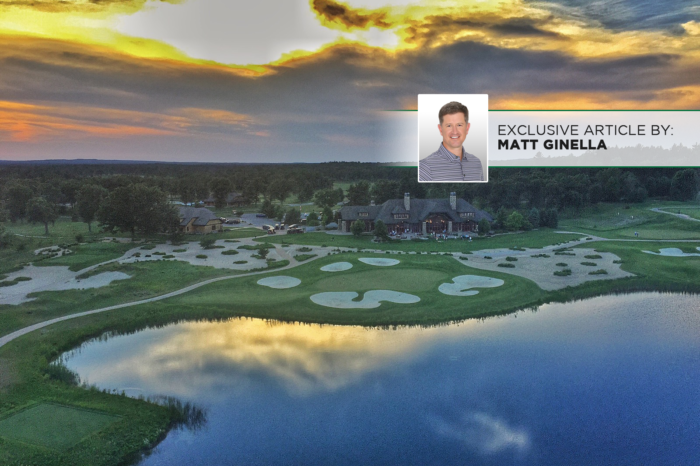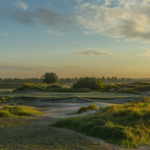Having toured 23 states, four countries on three continents, it has been another year of stories on short courses, sustainability, municipals, makeovers and effective grow-the-game initiatives.
At a place like Pinehurst, the “Cradle of American Golf,” one could argue, they’re embarking on almost all of the above: a trendy bar overlooking No. 2, a complete renovation of course No. 4, the addition of a short course and an extension of their popular putting course.
 On this website, I’ve already chronicled other significant investments being made by some of the top courses and resorts in the country, which includes Bandon Dunes, Pebble Beach, American Club, Sea Island, Sea Pines, Streamsong, Sawgrass, Forest Dunes, Arcadia Bluffs, Big Cedar Lodge and the Greenbrier, among many others.
On this website, I’ve already chronicled other significant investments being made by some of the top courses and resorts in the country, which includes Bandon Dunes, Pebble Beach, American Club, Sea Island, Sea Pines, Streamsong, Sawgrass, Forest Dunes, Arcadia Bluffs, Big Cedar Lodge and the Greenbrier, among many others.
 And the tent poles of golf are doing their part with continued support of First Tee, while creating their own initiatives, such as Drive, Chip and Putt and PGA Junior Leagues, which has enjoyed a 300-percent increase over the past three years and, worth mentioning, gets sponsorship for their championship from National Car Rental.
And the tent poles of golf are doing their part with continued support of First Tee, while creating their own initiatives, such as Drive, Chip and Putt and PGA Junior Leagues, which has enjoyed a 300-percent increase over the past three years and, worth mentioning, gets sponsorship for their championship from National Car Rental.
Meanwhile, Topgolf continues to sweep the country, as more people are seeing the merits of short, sustainable, accessible, affordable, non-traditional and FUN!
Go figure.
 But in the past 12 months of travel, it’s the stories on lesser-known grass-roots initiatives that make me so optimistic about the future of golf.
But in the past 12 months of travel, it’s the stories on lesser-known grass-roots initiatives that make me so optimistic about the future of golf.
For example, Youth on Course, which was started in 2006 by the Northern California Golf Association. The concept was simple: subsidize green fees for junior golfers. Now, 10 years later, there are 400 participating courses in 12 U.S. regions that have provided 450,000 rounds of golf for no more than $5 per round. Not to mention the addition of caddie programs, internships and college scholarships.
Credit goes to the NCGA for not only caring about the development of their junior members, but also for being so connected and supportive of other golf associations willing to adopt the program’s best practices.
 And although there are similar success stories, such as the Birdies program in Morocco, which is teaching and coaching 70 kids, not only to play the game, but also the management and the business of the industry, the idea that municipals matter was never more obvious than in 2016.
And although there are similar success stories, such as the Birdies program in Morocco, which is teaching and coaching 70 kids, not only to play the game, but also the management and the business of the industry, the idea that municipals matter was never more obvious than in 2016.
The city of Austin continues to rally national and historical support for Lions Municipal, which is where desegregation was happening in golf before it was happening in the country. And it’s where a 7-year-old Ben Crenshaw won his first of many golf tournaments. If the University of Texas turns Lions Muny into more high-rises and real estate profits, they’re going to suffer the public relations blues.
Meanwhile, Goat Hill Park in Oceanside, California has extended a 30-year lease to John Ashworth and his band of lovable and loyal locals, who just facilitated the conversion from potable to reclaimed water.
And in Winter Park, Florida, Keith Rhebb and Riley Johns, two young architects with decorated portfolios, have just completed a $1.2 million restoration of a 100-year-old 9-hole course that navigates roads, train tracks, a church and a graveyard.
Also worth noting, the work that has been done at Weequahic Golf Course in Newark, New Jersey, Canal Shores in the suburbs of Chicago, and Keney Park in Hartford, Connecticut.
And then there’s Torrey Pines North in San Diego, which gets 84,000 rounds per year and just underwent $25 million in changes by Tom Weiskopf, who kept the focus on playability for the people who pay to play as opposed to those who get paid to play.
Again, go figure.
And on the heels of golf coming back to the Olympics and Tiger Woods coming back to golf, Golf Advisor published an article using a 2015 graphic and study by the Sports and Fitness Industry which shows youth sports participation up in golf by 60.4%, while baseball, basketball, soccer and football down a combined 37.4%.
 I hear and see all of the counter arguments, which focus on a decrease in number of courses or the millennials’ lack of interest in the game. The fact is, not every course will make it. Nor should they. The industry has provided enough competition in various markets in which smarter and more demanding consumers seek out courses or destinations that are more proficient at meeting their needs and wants. Natural selection collides with laws of supply and demand, laws of economics, and eventually the strongest will not only survive, they will thrive.
I hear and see all of the counter arguments, which focus on a decrease in number of courses or the millennials’ lack of interest in the game. The fact is, not every course will make it. Nor should they. The industry has provided enough competition in various markets in which smarter and more demanding consumers seek out courses or destinations that are more proficient at meeting their needs and wants. Natural selection collides with laws of supply and demand, laws of economics, and eventually the strongest will not only survive, they will thrive.
And as for millennials, twenty-somethings have always struggled to justify the time and expense of golf while chasing careers, significant others and eventually, their offspring.
The long-term health of the game orbits around getting kids exposed to the fundamentals and fun of golf at an early age. And, eventually, when they get more time and income, they come back in their mid-30s or early 40s, as they recommit to family golf, buddies trips and couples trips.
I’m willing to bet everything I own, that investments made in 2016 will not only pay dividends in 2017, but more importantly, in 2027, and in 2037. I just hope I’m around to collect. Because, as any golfer knows, fast pay makes fast friends.

















































